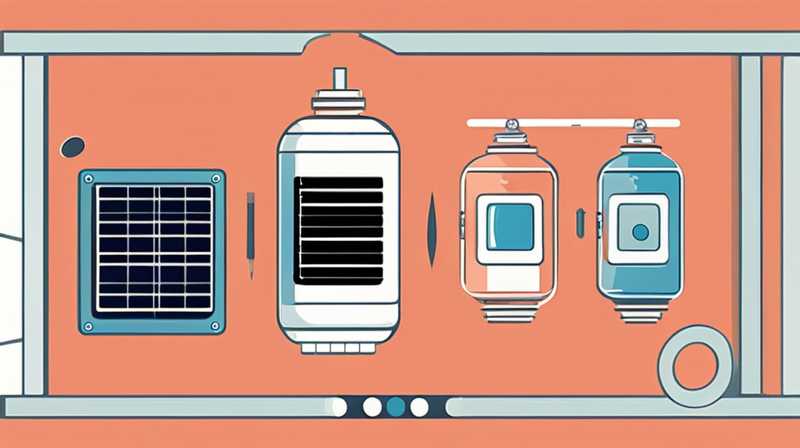
What to do if the solar valve is closed
Addressing a closed solar valve requires immediate attention to ensure system functionality. 1. Assess the situation, 2. Identify the cause, 3. Open the valve cautiously, 4. Monitor the system. Taking these steps ensures proper operation and prevents further issues in the solar heating system.
1. ASSESS THE SITUATION
Recognizing the initial signs of a closed solar valve is crucial. When the solar thermal system fails to function correctly, individuals may notice irregular temperature readings or insufficient hot water supply. It is essential to promptly determine whether these issues arise from the valve’s closure. Each component must be analyzed systematically to confirm if the valve is indeed shut.
Understanding the specific location of the solar valve is key. The majority of solar systems will have more than one valve, often installed in the piping that connects the collector to the storage tank. Familiarity with the system layout will improve the efficiency of the troubleshooting process. A visual inspection of the systems, coupled with relevant temperature readings, will provide a clear indication of whether the valve is closed.
2. IDENTIFY THE CAUSE
Once a closed valve is confirmed, exploring the underlying reasons becomes imperative. Common causes for the solar valve being closed might include maintenance procedures, control system malfunctions, or even environmental factors like freezing temperatures. Each of these scenarios can lead to significant disruptions in system operations.
In some cases, maintenance teams may inadvertently close the valve during routine inspections or upgrades. This oversight can lead to longer reaction times in restoration efforts. Furthermore, control system malfunctions, such as failed sensors, can signal the valve close when it is not necessary. Meanwhile, environmental issues, particularly during colder months, may cause the valve to close as a protective response to prevent damage.
3. OPEN THE VALVE CAUTIOUSLY
When ready to proceed with opening the valve, caution must be exercised to avoid damaging the system components. Using the appropriate tools to manipulate the valve ensures that adjustments occur smoothly. It’s advisable to refer to the system’s manual or guidelines specific to the valve type before making any alterations.
Support from a professional can greatly enhance the success rate in opening the closed valve. Engineers and service technicians are equipped with comprehensive knowledge and experience, ensuring the process is carried out effectively. A controlled and measured approach minimizes the risk of accidentally damaging other parts of the system.
4. MONITOR THE SYSTEM
Once the valve has been opened, continuous monitoring of the solar heating system is essential. Observing the operational indicators, such as temperature gauges and flow sensors, ensures that everything is functioning within the desired parameters. Should any abnormalities arise, taking prompt corrective action is necessary to prevent any further complications.
Monitoring should extend beyond the immediate operational checks. Implementing regular maintenance checks on a set schedule can help ascertain other potential issues before they escalate into major repairs. This proactive approach is beneficial in extending the lifespan of the solar system while also improving overall efficiency.
FREQUENTLY ASKED QUESTIONS
WHAT ARE THE SIGNS THAT A SOLAR VALVE IS CLOSED?
Identifying a closed solar valve often involves several indicators. Common signs include, insufficient hot water supply, unusual temperature readings, and system alarms or notifications. Homeowners may first notice a dramatic decrease in the availability of hot water, particularly during peak usage periods. This occurrence typically points to issues within the solar system.
Coupled with this, observing temperature gauges may reveal discrepancies, such as readings remaining stagnant or falling well below the expected threshold. Alarms may be audible within the system setup, particularly if one has installed a monitoring system that alerts users about performance variations. Addressing these signs and investigating their origins is vital for ensuring effectiveness.
HOW CAN I PREVENT MY SOLAR VALVE FROM CLOSING UNEXPECTEDLY?
Proactive measures can significantly reduce the likelihood of a solar valve closing unexpectedly. Regular maintenance and inspections play a crucial role, as does the installation of quality components. Monthly or seasonal check-ups conducted by professionals can identify any irregularities, allowing adjustments to be made before the situation worsens.
In addition, employing high-quality parts can lead to fewer mechanical issues overall. Using functionality-focused components helps reduce wear over time, diminishing the chances of unexpected breakdowns. These preventative actions help increase the longevity of the solar heating system, leading to improved reliability.
WHAT SHOULD I DO IF MY ATTEMPTS TO OPEN THE VALVE FAIL?
In instances where attempts to open the valve are unsuccessful, seeking professional assistance becomes imperative. A qualified technician can conduct a thorough examination of the system, diagnosing potential underlying issues that may not be readily apparent. Individuals who are not familiar with the complexities of solar systems may inadvertently cause more harm than good, emphasizing the need for expert intervention.
Technicians have the tools and experience necessary to deal with various issues, ensuring the system returns to optimal functioning. This approach prevents unnecessary downtime and supports the continued efficiency of the solar heating system, reaffirming the importance of professional input.
Navigating issues with a closed solar valve can appear intimidating at first; however, identifying symptoms and implementing the appropriate actions can rectify the situation efficiently. Investing time in understanding the system’s framework, coupled with observant monitoring and regular maintenance practice, reduces instances of valve closures. Furthermore, engaging skilled technicians fosters greater confidence in maintaining solar systems and results in more effective resolutions to potential complications. Ensuring long-term efficiency not only serves to extend the lifespan of the solar structures but also supports the sustainability goals surrounding solar energy utilization. Thus, maintaining a proactive attitude may yield significant dividends in preserving the performance and reliability of solar thermal systems.
Original article by NenPower, If reposted, please credit the source: https://nenpower.com/blog/what-to-do-if-the-solar-valve-is-closed-2/


